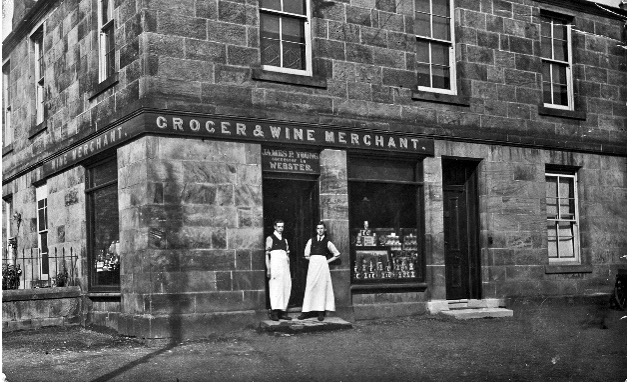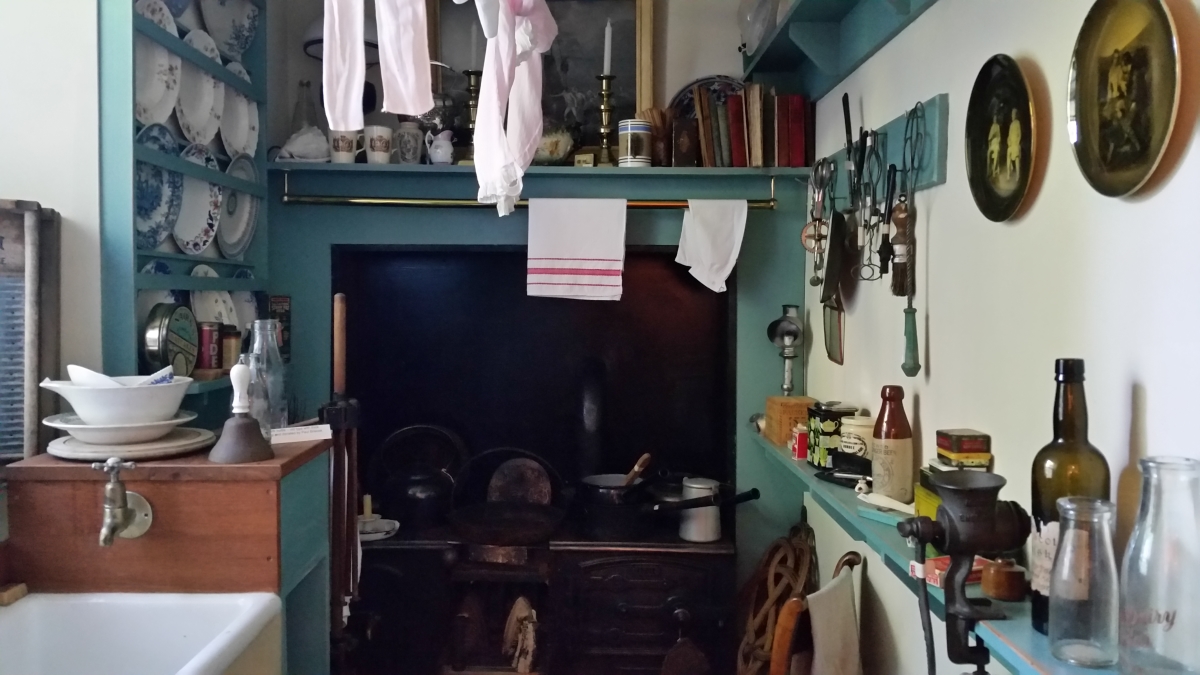Open every weekend from Easter to Christmas. Opening Times: Saturdays 11am to 1pm and 2pm to 4.30pm; Sundays 2pm to 4.30pm
Exhibitions
From prehistoric times to the present day, artefacts, documents and photographs illustrate the history of Dollar. A brief description of some of what may be seen is given below.
The 2024 Exhibition
Our exhibition is ‘Dollar Shops’. Our first picture (right or below) is a colourful view of Bridge Street in the 1970s. Observant viewers will see many differences between then and now, not least the loss of Stewarts Garage with its petrol pumps.
The exhibition looks at the multitude of shops that have existed in Dollar over the years. Some have had numerous owners, like The Deli, shown next, as it was in the early 1900s. It was always a grocery store. Other shops have remained a long time, with very different uses. Muckersie’s, on the right side of the first photo, was for 100 years a stationers, bookshop and printers. It was started by a relative of the author of Bradshaw’s Guide in the 19thcentury. Since then, it has been a bathroom fitting shop and is now Bridge Street Bar.
Other shops have disappeared. A map in the exhibition shows that there were over 40 shops in the 1950s. In the early 19th century shops were clustered in the Old Town, Hillfoot Road being called Traders’ Brae. Gradually, commerce moved to the New Town. The last shop to close in the Old Town was The Priory (our third photograph).
All of Dollar’s shops and some of the people who worked in them were recorded in our Millennium Project in 1999-2000. These photos will be available as a searchable database in the exhibition.
There are many interesting stories associated with Dollar Shops. We would be very pleased if visitors to the Museum would bring their memories and photos which we can add to the exhibition. We hope to have some walks associated with the exhibition and also to arrange some reminiscing sessions.
We also have: A combined working model of Dollar Railway Station and Dollar Mine showing the railway and some underground mine workings. The railway is as it was shortly before it was closed by Dr Beeching. This popular exhibit sits next to our Devon Valley Railway Exhibition with maps of the railway, exhibits, sound effects and audio commentary and a substantial collection of photographs in our reading room.
A small exhibition of Paintings by Local Artists including works by Adam Robson and Jennifer Campbell.
The Time-Line of Dollar History. This display extends round the entire exhibition area – some 25 metres – and transports you from geological times to the present day.
Local prehistoric finds.
Granny’s Kitchen and Children’s Corner with Victorian Toys and Dolls’ House.
Dollar Academy, the Japanese Garden at Cowden, and much more…
Reading Room with photos, maps, etc.
The Museum Shop – with souvenirs, gifts and booklets of interest
Opening Times: From Easter to Christmas. Normal weekend visiting times – Saturdays 11am to 1pm and 2pm to 4.30pm; Sundays 2pm to 4.30pm. No appointments necessary. To arrange a visit outside public opening hours, please contact dollarmuseum@btconnect.com

Bridge Stree, Dollar, in 1970s.

An earlier ‘Dollar Deli’ on the same site, Bridge Street, Dollar

‘The Priory’ shop, High Street, Dollar
Prehistoric
Local finds from Bronze Age burials on loan from the National Museums of Scotland give an insight into early inhabitants of the Hillfoots. Aerial photographs and maps show where the archaeological finds were made.
The Devon Valley Railway
The railway came to Dollar in 1869. From the 1950s until closure to passengers in 1964, Peter Wilson attempted to document all aspects of the Devon Valley Railway. He took photographs of the stations from Alloa to Kinross and recorded many bridges, signals, gradient signs, etc. He also collected timetables, tickets and leaflets. We have built on his collection and some interesting donations are on display. With the help of Awards for All, a completely new exhibition was mounted in 2009 and all 750 photographs taken by Peter Wilson can be seen in a slideshow. These are also documented in a searchable database and with funding assistance from the Scottish Community Foundation and EDF Energy Renewables have now all been printed.
Castle Campbell
Later inhabitants of Dollar lived in the shadow of Castle Gloum, renamed Castle Campbell, the lowland dwelling of the Earls of Argyll.
The Castle was burnt in 1654, and the ruin was sold along with the local Campbell lands around 1800. Early travellers and artists have left evidence of how the castle and village looked at this time, and these may be seen in the museum.
Dollar Academy
The small village with a woollen mill and a bleachfield changed after local boy John McNabb left a fortune which was used to found Dollar Academy in 1818. Dollar grew as the New Town was built to accommodate teachers, boarders and the families who moved to Dollar to take advantage of the low fees paid by residents of the village. Dollar Academy has gone on to become one of the top independent schools in Scotland.
More Exhibitions
Dollar and the Orient
An exhibition illustrating Dollar’s links with China and Japan.
The Japanese Garden at Cowden, near Dollar, was created by Ella Christie, an intrepid Victorian traveller who was the first European woman to visit Tibet. She employed a Japanese garden designer, Taki Handa, and a gardener, Shinzaburo Matsuo, who lived beside the garden for many years. The garden was described by Professor Suzuki as ‘the best in the western world’ and had many visitors, including Queen Mary.
James Legge travelled to China as a missionary and translator and later became the first Professor of Chinese at Oxford University. He sent his children to Dollar Academy and while on leave in Dollar in 1867 he invited the scholar Wang T’ao to help him translate the Chinese classics into English. Wang T’ao kept a diary during his two-year trip and wrote lively descriptions of his travels from Hong Kong to Scotland. The exhibition concentrates on his experiences in and around Dollar.
Churches
The Old Kirk of 1775 became too small to accommodate the congregation and in 1842 the New Church was built. The Disruption led to the building of the Free Church (the West Church, now private housing) and the 19th century also saw the building of the U.P. Church (now the East Burnside Hall) and the Episcopal Church, St James the Great.
Town Council
By the end of the 19th century Dollar had its own Town Council, and in 1913 the honour of having the first Lady Provost in Scotland: Lavinia Malcolm. Dollar Town Council disappeared with local government reorganisation in 1976, but a record of all the Provosts, together with photographs and other items are on display in the museum.

Granny’s Kitchen
With generous donations from Dollar people, we have been able to furnish our Granny’s Kitchen with an array of household items from washing dollies and wooden pulleys to butter pats and flat irons. Children will be particularly interested to see how a Dollar kitchen might have looked at the end of the 19th century.
How to find us
We are located in the village of Dollar, in Clackmannanshire, Scotland. Situated approximately 1 hour drive from Edinburgh and 45 mins from Glasgow.
Address
Dollar Museum
Castle Campbell Hall, 1 High Street
Dollar, Clackmannanshire
FK14 7AY
Entrance
FREE
Donations are welcome
Opening Times
The Museum is open from Easter to Christmas at the following times:
-Saturdays: 11am to 1pm, 2pm to 4.30pm
-Sundays: 2pm to 4.30pm
or by arrangement with the Curator (see Research page)
